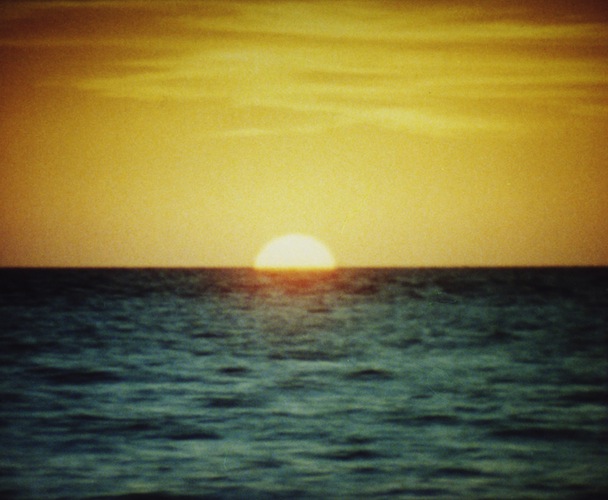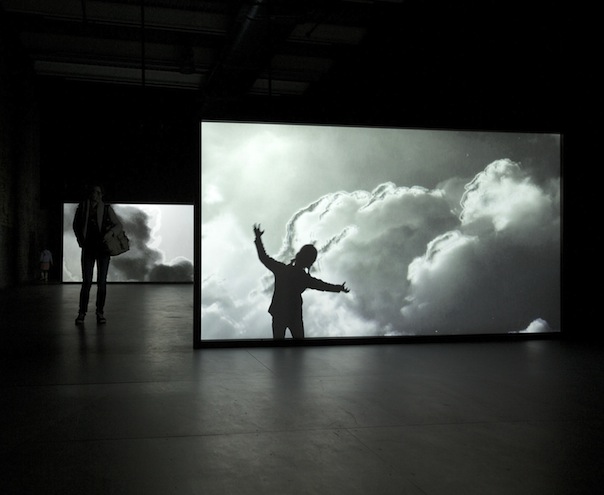Visual Arts Review: “The Dying of the Light” — An Elegy for the Beauty of Celluloid
This engaging exhibition features the work of 6 artists who meditate on the demise of the analog film image, exploring celluloid’s “particular visual, material, aural, and even metaphoric characteristics.”
The Dying of the Light: Film as Medium and Metaphor, at Mass MoCA, North Adams, MA, through January, 2015

Tacita Dean, “The Green Ray,” 2001. At “The Dying of the Light” at MASS MoCA in North Adams, Massachusetts. Photo: Courtesy of the artist.
By Anthony Merino
MASS MoCA curator Susan Cross refers to The Dying of the Light: Film as Medium and Metaphor as a “love letter to celluloid.” Actually, it is more of an elegy for what has been lost in our age of digital images. Today, film has become an antiquated technology: it is more expensive, less accessible, has a larger carbon footprint and is more fragile than digital technology. This engaging exhibition features the work of 6 artists — Rosa Barba, Matthew Buckingham, Tacita Dean, Rodney Graham, Lisa Oppenheim, and Simon Starling – who meditate on the demise of the analog film image, exploring celluloid’s “particular visual, material, aural, and even metaphoric characteristics.”
Projected movies flicker and vibrate. The strip can get scratched, which creates random vertical lines on the screen. Barba, an Italian visual artist, proves that these ‘flaws’ have their own distinctive beauty in Stating the Real Sublime (2009). A projector is suspended, via the film it is projecting, from the gallery ceiling. The movement of the belt through the projector causes the machine to rock back and forth, which makes it torque slightly so that the image blinks and bounces. The visual rhythm, along with the hum of the projector, creates an oddly hypnotic atmosphere. The inventive incorporation of the idiosyncrasies of analog film in Stating the Real Sublime makes the piece stand out among the others in the exhibition. Most of the other artists either deal with the history of cinema or examine how the illusion of movement is made.
Matthew Buckingham’s False Future (2007) and Simon Starling’s Black Drop, 2012 document the history of trying to create movement on film prior to Edison or Lumières’s development of motion picture cameras and projectors. The former tells the story of Louis Le Prince, who may have invented moving images five years before Auguste Marie Louis Nicolas and Louis Jean Lumière had their first screening. The installation includes chairs, a projector, and a sheet on which the movie is projected. Buckingham attempts to recreate Le Prince’s working studio with wooden folding chairs and a makeshift screen. The film depicts a bridge and is narrated in French with English subtitles.
Starling makes use of an astrological event, a transit of Venus across the Sun, to dramatize the discoveries in perception that led to photography and the moving picture. The last two transits were in 2004 and 2012; the next transit will be 2117. The movie was shot on 35mm film and transferred to video. Black Drop tells the story of how a camera obscura was initially used in 1544 to project a moving image of the transit of Venus. This was followed by the addition of telescope lenses, which gave the 17th century Jesuit priest and astronomer Christoph Scheiner an opportunity to transcribe the changing shape of sunspots onto paper. The video ends with an editor splicing together film and a shot of the actual transit of Venus taken in 2012.
The transit of Venus has a rhythm; the cycle takes about 250 years before it repeats. Several artists deal with our perception of pattern as the central element in their work. England’s Tacita Dean has contributed one of The Dying of the Light’s most seductive pieces. The Green Ray (2001) depicts a sun setting over a seascape. The entire image has been given a dirty amber tint. In this piece, Dean explores our ability to understand motion as it is shaped by our sense of time. The aim is to emphasize our perceptual disjunction: the sun moves too slowly to appear to be moving, while the waves on the sea move quickly.

Lisa Oppenheim, “Smoke,” 2013.At “The Dying of the Light” at MASS MoCA in North Adams, Massachusetts. Photo: Arthur Evans
Lisa Oppenheim presents a dense study in perception with Yule Log (2009). We first see a log burning in a fireplace. As the film continues, the image becomes increasingly blurred until it turns into a white mass with orange accents. The image is bracketed with two large screens that project video of billows of smoke. Oppenheim uses an elaborate process of image capture, distortion, and recapture to create what looks like the disintegration of the image. Yule Log undermines our confidence in film’s stability. if you began to view the movie after the image has been blurred, it would completely illegible. But if you watch the movie from the beginning, you would read the image as a fireplace well into its decomposition.
Like Oppenheim, Rodney Graham radically plays with the moving image in Torqued Chandelier Release (2005), a black-and-white movie that depicts a spinning chandelier that stops and reverses motion. Shot at twice the speed of regular film, the movie must be screened with a custom made projector. Imposing, loud, and awkward, the projector becomes an unforgettable part of the piece. The most interesting aspect of this work is the contrast Graham creates between the elegant patterns of his images and the clunky audio accompaniment of the projector, which hacks and spits.
The Dying of the Light underscores a powerful irony: the ease with which photographs can be manipulated, film’s inevitable imperfections, lends movies a peculiar kind of veracity, a graphic truthfulness, that neither its predecessors (painting and printing) nor its omnipresent successor (digital) have.
Anthony Merino is an unaffiliated artist and critic working out of Adams, Massachusetts. He has published and presented papers on contemporary art internationally. Additional articles are available here.
Tagged: Anthony Merino, Film, Film as Medium and Metaphor, Lisa Oppenheim, Matthew Buckingham, Photography, Rodney Graham, Rosa Barba, Simon Starling, Susan Cross, Tacita Dean
